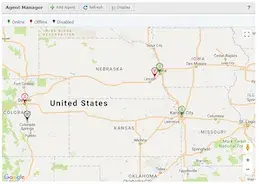Automate Your File Transfers
File transfer automation allows you to manage recurring or high-volume file transfers, all while reducing or eliminating manual data processing.
Many organizations today still have tedious file transfer processes, complicated system setups, or manually transfer large files and bulk batches regularly. Automation simplifies and streamlines these everyday tasks; not only can it help reduce human error, it can save time and cut costs.
If you’re looking for file transfer automation software to help support your automation goals, you’ve come to the right place! Forget scripts, homegrown processes, and legacy PC tools. Automatic file transfer software, like GoAnywhere MFT allows its users to effortlessly configure when files should move between internal systems, other users, or trading partners.
How Does File Transfer Automation Work?

Automation involves using electronics or computer-controlled devices to have each step of a process run one after the next without human intervention. File transfer automation is the use of technology to monitor and control file movements, including sending, retrieving, and delivering data.
Related Reading: Everything You Need to Know About FTP Automation
File transfer automation solutions help you make processes more efficient. With automatic file transfer, you can schedule when files should be sent or retrieved between systems, users, trading partners, applications, or the cloud. Automation is often used to manage recurrent file transfers, especially for high volumes of transfers.
File transfer automation can be more than just a file moving tool. Some solutions can monitor folders both on-premises or in the cloud, send you emails and SMS alerts when triggered events occur, and test and debug your automatic file transfer workflows.
Automated Data Transfer Benefits
When you automate data transfers, you can choose when files move between systems internally, between users, and trading partners, either by scheduling file transfers or setting up “triggers” that set off data movements once a specified event occurs.
Why use data transfer automation?
Related Reading: Is Automation All It’s Cracked Up to Be?
Once an automation schema is established, your file transfer automation solution can execute the workflows for transfers precisely and in the correct sequence, helping to eliminate human errors. Being able to forecast file transfer completion and having the ability to quickly resume file transfers or troubleshoot failed transfers can eliminate an abundance of the guesswork from daily tasks.
Types of File Transfer Automation Features
File transfer automation often includes features built to simplify your day to day. These features will execute in the background, track their own movements, and begin and end processes based on triggers that you identify ahead of time.
Automated Scheduling
Automated Workflows
Automate Data Movements Across the Board
Automating Large File Transfers
Without the right solution, transferring large files can trip up even the most seamless file transfer process. Organizations that need to routinely share and send large files, or large batches of files, frequently turn to file transfer automation as a solution. By using a file transfer workflow, you can streamline your processes from beginning to end and rest assured that your data will be encrypted, tracked via audit and activity logs, and delivered successfully to the recipient.
When choosing a method for automating your large file transfers, some features to look for include:
- Unlimited file size transfers and volume capacities
- Built-in schedulers
- Functionality for batch file automation
- Secure email capabilities
- Auto-resume
- Audit logs and reporting
- Speed of file transfers
Related Reading: How to Send Large Files
Overall, file transfer automation is proven to reduce the time admins spend on large file transfers for the enterprise, freeing up room to work on other projects.
MFT Automation
Automation is one of the key benefits of using MFT. By taking repetitive tasks prone to errors off of employees’ shoulders, business processes can be streamlined, consistent, and error-free. MFT automation helps organizations:
- Add efficiency and cost savings by automating workflow and file automation for authorized projects with one click ease, even for re-occurring or high-volume transfers, so employees can focus on more high-priority vs time-consuming manual tasks.
- Add control with a built-in scheduler to manage when files should move between internal systems or between trading partners.
- Add security with built-in, automated encryption to protect files in transit and at rest.
- Meet compliance requirements with auditing capabilities and transparency around file activities and strong encryption.
- Reduce errors by minimizing the risks of errors or mishandling from manual file transfer activities.
- Provide more reliable transfers with automatic re-tries to ensure file transfers are completed even if something goes wrong with the network.
About GoAnywhere MFT
Secure file transfer is important for every organization. Juggling multiple tools and utilizing manual methods will always slow down operations. GoAnywhere Managed File Transfer (MFT) is a robust solution that automates and manages file transfers using modern data security standards. It’s a good feeling knowing that files at rest and in motion are protected against ill-intentioned parties. Regardless of file size and volume, GoAnywhere MFT reconnects and resumes file transfers and notifies you via email or text alerts of transfer statuses.
Automation is Key

File transfer automation software is a powerful tool to have in your toolbelt. As a secure FTP automation software solution, GoAnywhere MFT lets users quickly automate file transfers and schedule projects to run using its built-in scheduler or any existing scheduler software. Built-in scheduling allows for executing workflows at future dates and times. You can schedule workflows as “one time” or to run every minute, every hour, or every day – whatever or whenever your preference.
Calendars can even be easily customized to ensure workflows don’t run on days they shouldn’t. Workflows (Projects) can also be automated, executing whenever a file monitor detects new, modified, or deleted files in targeted folders. The file monitor can also alert you if an error occurs during the process, such as a file failing to reach its intended location. Goodbye manual work, hello simplicity!
Workflows can be called from local and remote command lines, scripts, and programs using the provided commands and APIs. They can additionally be called as Web Services using SOAP or REST requests. To execute Workflows based on user activity, triggers can monitor for events like when a file is uploaded or downloaded. Setting a trigger allows you to set in motion a sequence of actions prompted by an event. Triggers eliminate the time-consuming process of manually completing routine follow-up tasks.
Automating Workflows in GoAnywhere
Users can achieve workflow and file automation with a single click within GoAnywhere’s browser-based administrator. GoAnywhere MFT can not only execute multiple projects with its job management system, administrators can define multiple job queries to group projects that share common characteristics or service level agreements (SLAs).
Each job queue can define the priority of their jobs, as well as the maximum number of concurrent jobs that can be executed from the queue. Job queues can be managed and prioritized through GoAnywhere's Administrator interface.
Workflows can also be executed in Debug mode, which allows users to interactively execute tasks one step at a time. At each stopping point, the values for the variables can be viewed or changed before the next task is executed.
SFTP Automation
SFTP automation streamlines the process of exchanging data over a secure SFTP connection. SFTP automation is baked into GoAnywhere for a centralized, enterprise-level solution and can also automate other secure FTP connectivity such as FTPS, AS2, and HTTP).
SFTP automation adds efficiency to multiple transfer processes including:
- Workflow projects and tasks
- File monitoring
- Encryption
- Scheduling
- Cloud data exchanges
- Recurring file transfers
Files can be automatically sent or retrieved between systems, users, trading partners, applications, or the cloud. And administrators can quickly establish workflows and tasks to provide end-to-end automation for SFTP file transfers to add efficiency to multiple business processes. In addition, automation can help reduce the risks that come with manual file transfer function.
With a managed file transfer solution, automation adds additional advantages, including the ability to monitor folders on-premises or in the cloud, receive alerts when triggered events occur, and test and debug file transfer workflows.
Here’s what an SFTP automation workflow looks like:
- You create a workflow to retrieve remote inventory updates from an SFTP trading partner every Friday at 8 a.m.
- When that time occurs, the workflow reaches out across the secure SFTP connection, accesses a secure folder on your partner’s network, and retrieves the documents.
- Once the documents are back in your network, the workflow automatically decrypts the files, translates them into different file formats (e.g., CSV, XML), and drops them into a folder for your team to process further.
Remote Automation Solutions with GoAnywhere Agents
MFT agents are lightweight applications that allow administrators to remotely control automated file transfers and file processing from a central GoAnywhere server. Agents can be installed virtually anywhere, such as servers and desktops located on-premises, external systems like retail locations or trading partners, or even in the cloud.

Install Agents Anywhere
Agents can be installed onto almost any server or workstation where file transfers or workflows need to be performed. These systems can reside on-premises or in cloud infrastructure.
- Windows
- Linux
- IBM i
- Mac OS
- Azure
- Amazon EC2

Agent Maps
Agents can be monitored and managed via an interactive map. Agents are color coded to indicate if they are online or offline. Simply click on a pin location to launch the Agent console. Agent maps allow you to:
- See your worldwide agent deployment anytime, anywhere.
- View the agent console from the central GoAnywhere server.
- Edit and process agents grouped in the same location.
How Your Peers Achieve Automation with GoAnywhere
Government: Adams County, Colorado
The fifth largest county in Colorado, Adams, discovered a streamlined, consistent way to automate their file transfers between internal systems, external systems, and trading partners with GoAnywhere MFT.
To facilitate a payroll project, the team in Adams County started using GoAnywhere's run-time mode to verify that files are correct before going out. As soon as the files are approved by staff, they're sent out with the click of a button.
Read the Full Story: Automating File Transfers Across Multiple Systems
Banking & Finance: Sentinel Benefits & Financial Group
Security is essential to financial file transfers. After years of batch scripts and manual processes, Sentinel Benefits & Financial Group now relies on file transfer automation software to automate and send data securely and efficiently.
In one notable example, Sentinel implemented GoAnywhere to assess management fees for the retirement advisory arm of the business. Prior to using GoAnywhere, Sentinel employees manually posted fee transactions: because fees are sometimes paid from plan assets, fee transactions must be posted to withdraw money to cover the costs. Thanks to GoAnywhere, the transactions are now handled automatically, with 600-700 transactions running in seconds rather than employees completing each transaction manually.
Read the Full Story: Recouping Lost Time with a Secure MFT Solution
Manufacturing: Dayton Parts
As a manufacturer and distributor of thousands of parts for trucks, Dayton Parts' primary focus is their customers. Before moving to GoAnywhere MFT, staff members spent nearly 100 hours manually extracting and pasting data into emails over a 6-day period — all because the inventory and processing procedure involved going outside a normal IBM i (iSeries) server function. Learn how Dayton Parts automated their growing file transfer needs and simplified data distribution with GoAnywhere Managed File Transfer — reducing time spent on the old process from six days to three hours.
Read the Full Story: Automating Data Movement and Distribution
See How GoAnywhere Can Help Your Organization with File Transfer Automation
Maximize Automation and Workflow: Resources from GoAnywhere
Try a Leading Managed File Transfer Solution Risk Free
Take GoAnywhere MFT for a spin for 30 days. Start a free trial and see how MFT can support your organization.